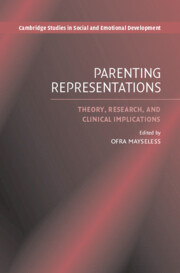Book contents
- Frontmatter
- Contents
- List of Illustrations
- List of Tables
- List of Appendixes
- List of Contributors
- Preface
- Acknowledgments
- Part One Theoretical Perspectives
- Part Two Research Applications
- 4 Communicating Feelings: Links Between Mothers' Representations of Their Infants, Parenting, and Infant Emotional Development
- 5 The Dual Viewpoints of Mother and Child on Their Relationship: A Longitudinal Study of Interaction and Representation
- 6 Modeling and Reworking Childhood Experiences: Involved Fathers' Representations of Being Parented and of Parenting a Preschool Child
- 7 Maternal Representations of Parenting in Adolescence and Psychosocial Functioning of Mothers and Adolescents
- 8 Like Fathers, Like Sons? Fathers' Attitudes to Childrearing in Light of Their Perceived Relationships with Own Parents, and Their Attachment Concerns
- Part Three Clinical Implications
- Index
- Cambridge Studies in Social and Emotional Development
- References
7 - Maternal Representations of Parenting in Adolescence and Psychosocial Functioning of Mothers and Adolescents
from Part Two - Research Applications
Published online by Cambridge University Press: 10 July 2009
- Frontmatter
- Contents
- List of Illustrations
- List of Tables
- List of Appendixes
- List of Contributors
- Preface
- Acknowledgments
- Part One Theoretical Perspectives
- Part Two Research Applications
- 4 Communicating Feelings: Links Between Mothers' Representations of Their Infants, Parenting, and Infant Emotional Development
- 5 The Dual Viewpoints of Mother and Child on Their Relationship: A Longitudinal Study of Interaction and Representation
- 6 Modeling and Reworking Childhood Experiences: Involved Fathers' Representations of Being Parented and of Parenting a Preschool Child
- 7 Maternal Representations of Parenting in Adolescence and Psychosocial Functioning of Mothers and Adolescents
- 8 Like Fathers, Like Sons? Fathers' Attitudes to Childrearing in Light of Their Perceived Relationships with Own Parents, and Their Attachment Concerns
- Part Three Clinical Implications
- Index
- Cambridge Studies in Social and Emotional Development
- References
Summary
Abstract
The notion of caregiving representations was applied to assess parenting representations of mothers of adolescent sons. The association between these representations and the mothers' state of mind with respect to attachment was examined. In addition, mothers' parenting representations were examined as predictive of the coping of the sons with the developmental tasks of leaving home and individuation. Eighty-two mothers of male adolescents from middle-class intact families were administered the Parenting Representations Interview-Adolescence (PRI–A) approximately a year prior to the son's conscription to mandatory military service. The coping and adaptation to the basic training period as well as levels of individuation three years later were assessed. Mothers' parenting representations were moderately associated with their own AAI categorizations. Mothers' parenting representations were further predictive of the psychosocial developmental accomplishments of their sons. These findings attest to the significance of the mothers' parenting representations in affecting the sons' experiences as part of their developmental trajectory.
Within the paradigm of attachment theory, the interest in parents' caregiving system, namely their motivational system to give care and protection, started to rise a decade ago (George & Solomon, 1989, 1996; Bretherton et al., 1989). This interest was reflected in the study of parents' internal world, their beliefs, emotions and affects, that is, their parenting representations. Several researchers in different laboratories have suggested various ways of assessing parenting representations.
- Type
- Chapter
- Information
- Parenting RepresentationsTheory, Research, and Clinical Implications, pp. 208 - 238Publisher: Cambridge University PressPrint publication year: 2006
References
- 8
- Cited by



